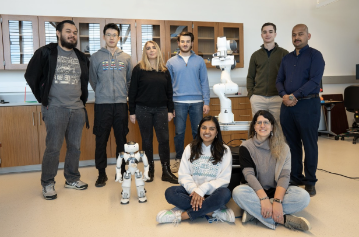Written by Professor Maria Kyrarini
April 24, 2024
My main research and teaching is centered on how we use AI for Robotics and how we can build robots that are more human-like in the way they behave in the future. I feel that this field has huge potential to grow over the next few years, especially taking into account pain points where we see labor shortages in various industries. The area of nursing and healthcare is an example. Our population is getting older and we already need more technology assistance. If we have AI-powered assistive robots, this could definitely help many people with everyday tasks.
We are moving towards that direction but we haven’t arrived yet, with issues like hardware safety and privacy, in relation to having devices that have cameras that monitor our daily lives. There are also questions about inclusivity about how we can build systems that are inclusive for everyone.
"I think that being connected to the community and remembering who we are building for is the best way to ensure that we are co-creating a long lasting impact..."
In moving forward with AI technology, I think that being connected to the community and remembering who we are building for is the best way to ensure that we are co-creating a long lasting impact alongside AI and robotics. I was teaching a graduate class that had to do with designing assistive technologies and in the very first week of class, we decided to actually visit the Vista Center for the Blind and Visually Impaired. We had a panel discussion with representatives from the Center and then I said to the students that this was a project based course inspired by the wish list that the people in the panel discussed. The students developed an app and I have to admit that they put in way more hours than I would have expected. At the end of the class, they went back to the Vista Center to show them what they had developed. The students cared more about the cause, than the grade they would receive in the course.
Also in my Fall 2023 Robotics Class, students had to define their projects and what they were supposed to work on by going and talking to people. Their first task was identifying a real problem. For example, I had one team that wanted to talk to the Fire Department. The firefighters actually identified critical tasks that are dangerous for them to do that they would prefer robots do instead. Introducing robots and AI is not fundamentally about replacing humans. It’s about reallocating the resources, in this case, to ensure human safety.
For students entering the workforce and for current employees that are having to grapple with this emerging technology, it’s important that we have a theoretical background for many things we learn. Sometimes it's easier if we simply start with strategic and practical steps that provide quick results for us, but understanding the mechanics allows us to wield the technology as our own. Santa Clara University students care about each other, the community, and how they can make the world a better place. As we understand AI and Robotics properly, we will be able to use this technology for long-term value because of that human factor.

Dr. Maria Kyrarini is an Assistant Professor of Electrical and Computer Engineering and David Packard Jr. Faculty Fellow at Santa Clara University (SCU). She also leads the Human-Machine Interaction & Innovation (HMI^2) research group which has been supported by federal (NSF) and SCU internal grants. Prior to SCU, she was a postdoctoral research fellow at the University of Texas at Arlington and the assistant director of the Heracleia Human-Centered Computing Lab. In 2019, Maria received her Ph.D. in Engineering from the University of Bremen. The title of her Ph.D. thesis is: "Robot learning from human demonstrations for human-robot synergy". Before that, she received her M.Eng. degree in Electrical and Computer Engineering and her M.Sc. degree in Automation Systems both from the National Technical University of Athens (NTUA) in 2012 and 2014, respectively. Her primary research interests are in the fields of Robot Learning from Human Demonstrations, Human-Robot Interaction, and Assistive Robotics with a special focus on enhancing Human Performance.
*Photo: Members of the Human-Machine Interaction & Innovation Lab (http://hmi2.org/) in AY 2022-2023 (from left to right: Aly Khater, Justin Sun, Manizheh Zand, Fernando Camou, Matt Tognitti, Krishna Kodur, bottom: Neena Ekanathan, Prof. Maria Kyrarini)
